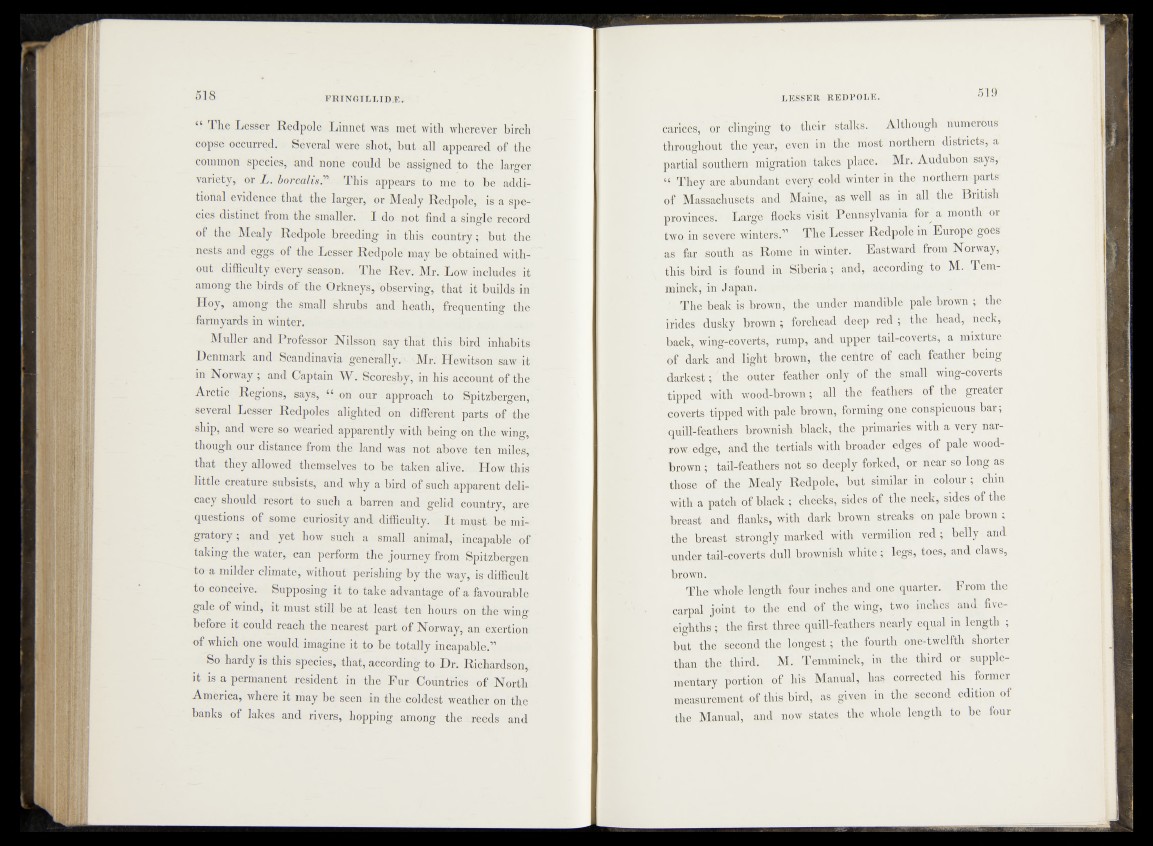
“ The Lesser Redpole Linnet was met with wherever birch
copse occurred. Several were shot, but all appeared of the
common species, and none could be assigned to the larger
variety, or L. borealis.” This appears to me to be additional
evidence that the larger, or Mealy Redpole, is a species
distinct from the smaller. I do not find a single record
of the Mealy Redpole breeding in this country; but the
nests and eggs of the Lesser Redpole may be obtained without
difficulty every season. The Rev. Mr. Low includes it
among the birds of the Orkneys, observing, that it builds in
Hoy, among the small shrubs and heath, frequenting the
farmyards in winter.
Muller and Professor Nilsson say that this bird inhabits
Denmark and Scandinavia generally. Mr. Hewitson saw it
in Norway ; and Captain W . Scoresby, in his account of the
Arctic Regions, says, 44 on our approach to Spitzbergen,
several Lesser Redpoles alighted on different parts of the
ship, and were so wearied apparently with being on the wing,
though our distance from the land was not above ten miles,
that they allowed themselves to be taken alive. H ow this
little creature subsists, and why a bird of such apparent delicacy
should resort to such a barren and gelid country, are
questions of some curiosity and difficulty. It mnst be migratory
; and yet how such a small animal, incapable of
taking the water, can perform the journey from Spitzbergen
to a milder climate, without perishing by the way, is difficult
to conceive. Supposing it to take advantage of a favourable
gale of wind, it must still be at least ten hours on the wing
before it could reach the nearest part of Norway, an exertion
of which one would imagine it to be totally incapable.”
So hardy is this species, that, according to Dr. Richardson,
it is a permanent resident in the Fur Countries of North
America, where it may be seen in the coldest weather on the
banks of lakes and rivers, hopping among the reeds and
carices, or clinging to their stalks. Although numerous
throughout the year, even in the most northern districts, a
partial southern migration takes place. Mr. Audubon says,
“ They are abundant every cold winter in the northern parts
of Massachusets and Maine, as well as in all the British
provinces. Large flocks visit Pennsylvania for a month or
two in severe winters.” The Lesser Redpole in Europe goes
as far south as Rome in winter. Eastward from Norway,
this bird is found in Siberia ; and, according to M. Tem-
minck, in Japan.
The beak is brown, the under mandible pale brown ; the
irides dusky brown ; forehead deep red ; the head, neck,
back, wing-coverts, rump, and upper tail-coverts, a mixture
of dark and light brown, the centre of each feather being
darkest; the outer feather only of the small wing-coverts
tipped with wood-brown; all the feathers of the greater
coverts tipped with pale brown, forming one conspicuous bar;
quill-feathers brownish black, the primaries with a very narrow
edge, and the tertials with broader edges of pale wood-
brown ; tail-feathers not so deeply forked, or near so long as
those of the Mealy Redpole, but similar in colour; chin
with a patch of black ; cheeks, sides of the neck, sides of the
breast and flanks, with dark brown streaks on pale brown ;
the breast strongly marked with vermilion red ; belly and
under tail-coverts dull brownish white; legs, toes, and claws,
brown.
The whole length four inches and one quarter. From the
carpal joint to the end of the wing, two inches and five-
eighths ; the first three quill-feathers nearly equal in length ;
but the second the longest; the fourth one-twelfth shorter
than the third. M. Temminck, in the third or supplementary
portion of his Manual, has corrected his former
measurement of this bird, as given in the second edition of
the Manual, and now states the whole length to be four